A Quad-Element UWB-MIMO Antenna with Band-Notch and Reduced Mutual Coupling Based on EBG Structures
Abstract
A compact planar quad-element ultrawideband (UWB) antenna with a band-notch and low coupling for multiple-input multiple-output (MIMO) system is proposed in this paper. The antenna consists of four circular monopoles with modified defected ground plane and a periodic electromagnetic band gap (EBG) structures. The proposed EBG structures are modified from the traditional mushroom-like ones, comprised of patterns of grids on the top patch, the metallic ground plane, and several vias that connect the top and bottom plane. It is printed at the center of the dielectric substrate to lower electromagnetic coupling between the parallel elements. Besides, by etching four crescent ring-shaped resonant slots on the radiators, a sharp band-notched characteristic is achieved. From the experimental results, the −10 dB bandwidth of the antenna is extended covers from 3.0 to 16.2 GHz, with a sharp notched band at 4.6 GHz. And the isolation is greater than 17.5 dB between its elements, with a peak gain of 8.4 dB and a peak efficiency of 91.2%. Moreover, it has a compact size of 0.6λ × 0.6λ × 0.016λ at 3 GHz and could be a good candidate for portable devices.
1. Introduction
Since Federal Communications Commission (FCC) released the spectrum from 3.1 to 10.6 GHz for commercial applications [1], ultrawideband (UWB) technology has drawn considerable attention due to its merits of low complexity, low-power consumptions, capability of high data rate, low interference, good time-domain resolution, and reduction of severe multipath effect [2]. Although UWB communication system makes use of huge frequency bands, the permitted power spectral density of the UWB signal is rather limited to avoid interference with other systems, such as the frequency band from 4400 to 4990 MHz, which is adopted in large capacity microwave relay trunk network. Multiple-input-multiple-output (MIMO) technology enables the transmission of data over multiple channels and increases the channel capacity without additional power requirements; thus, it has been widely used in modern wireless communication system [3]. Furthermore, compact and planar antenna designs are of great demand since they are easier to integrate with wireless devices [4].
As a key technology for next-generation communication systems, MIMO technique can increase the capability and reliability without additional power or spectrum [5]. To achieve good performance and compact structure, good isolation between closely-spaced antennas is required for MIMO communication systems [6]. In [4], a compact quad-element wideband antenna with slotted ground plane is presented. By etching a modified slotted ground plane, the bandwidth is extended covers from 2 to 6 GHz with a compact size of 0.33λ × 0.33λ × 0.01λ at 2 GHz, but the isolation is only 14 dB between its elements. In [7], a wideband MIMO antenna with common elements suitable for WiFi and LTE wireless access point application is proposed. It consists of four microstrip feedline-printed monopole antennas with common radiating element and a ring-shaped ground plane; the impedance bandwidth is enhanced from 1.8 to 2.9 GHz by common element particular design. However, it only results in isolation of 15 dB in the operating frequency band. In [8], a four-element MIMO patch antenna is designed for 2.45 GHz band operation. For the purpose of antenna miniaturization, it adopts complementary split-ring resonator (CSRR) loading on its ground plane, which reduces the single-element antenna size by 76%. But, the isolation of the antenna only achieves −10 dB. In [9], a dual element stacked patch antenna is designed for MIMO technology, it achieves a high isolation, and the minimum isolation reaches 31 dB mainly due to the orthogonal polarization modes of the two excited ports. Nevertheless, the relative operating frequency bandwidth is only 4.3% from 3.65 to 3.81 GHz and the overall dimension is 0.99λ × 1.05λ × 0.03λ at 3.65 GHz which is obviously large in miniaturization portable devices.
In this paper, a compact UWB-MIMO antenna with a band-notch and reduced mutual coupling is presented and fabricated. The initial design of a single element includes a circular monopole at the top layer of the dielectric substrate and a modified defected ground structure at the bottom layer to obtain an ultrawideband. Besides, a crescent ring-shaped resonant slot is etched on the surface of the circular monopole to achieve a band-reject to inhibit the interference of large capacity microwave relay trunk network. The orthogonal placement of the elements can ensure the low coupling between the orthogonal element (e.g., 1-2 and 1–4) and a 3 × 3 array electromagnetic band gap (EBG) structure can ensure high isolation between the parallel elements (e.g., 1–3 and 2–4). From the experimental results, the proposed antenna has ultrawideband covers from 3.0 to 16.2 GHz, the band-notch centered at 4.6 GHz covers from 4.0 to 5.2 GHz, and good isolation of 17.5 dB between every two elements is achieved. Besides, radiation pattern, gain, efficiency, envelope correlation coefficient (ECC), total active reflection coefficient (TARC), mean effective gain (MEG), diversity gain (DG), and channel capacity loss (CCL) are measured and calculated.
2. Proposed Antenna Configuration
The proposed antenna is fabricated on the low-cost FR4 substrate with a relative permittivity of 4.4, thickness of 1.6 mm, and loss tangent of 0.02. Electromagnetic simulator HFSS is used for calculating S-parameters, gain, efficiency, radiation pattern, ECC, TARC, MEG, DG, and CCL, while the dispersion characterization of surface waves propagating on the EBG structures is investigated by CST MWS.
2.1. Single-Element Antenna
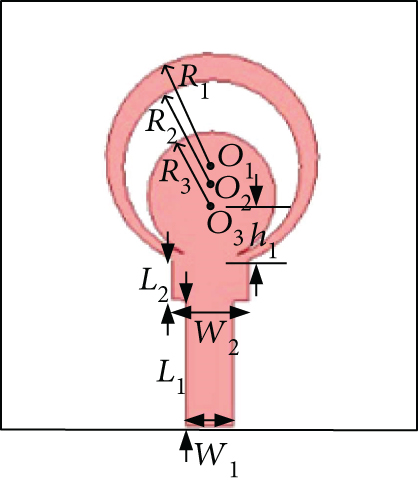

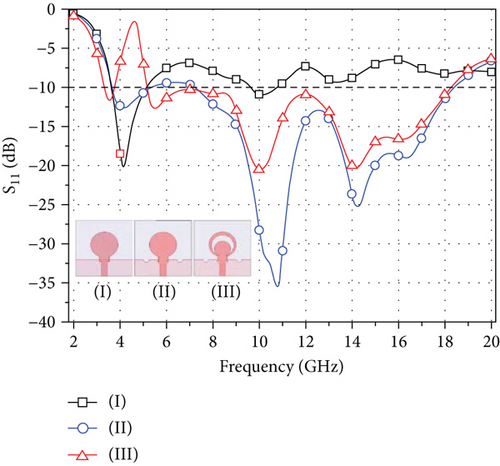
2.2. Integration of a Four-Element Antenna
By using the element proposed in the previous section, a simulated model of a quad-element UWB-MIMO antenna is built as shown in Figure 3(a). Individual elements, occupying an area of 0.08λ2, are placed rotationally and symmetrically in a square substrate with an interval of 90°. As illustrated in Figure 4, the S-parameters between parallel element (i.e., 1–3 and 2–4) exhibit a suppressed isolation, overwhelmingly lower than 17.5 dB in the frequency band of 5.1 GHz–5.6 GHz and 7.3 GHz–9.1 GHz. However, the orthogonal arrangement of elements (i.e., 1-2 and 1–4) exhibits good isolation, which is mainly greater than 20 dB in the whole band. The orthogonal arrangement of elements in the antenna can ensure a good isolation between adjacent elements, which is due to the orthogonal polarization field produced in the elements and the mutual coupling is reduced. However, the parallel elements can produce the symmetrical electromagnetic field and the similar polarization; thus, the power will flow from antenna 1 to antenna 3 (antenna 2 to antenna 4) when they are excited, which leads to the high coupling between parallel elements. In Section 3, the EBG structures are proposed to inhibit the mutual coupling between the parallel elements.
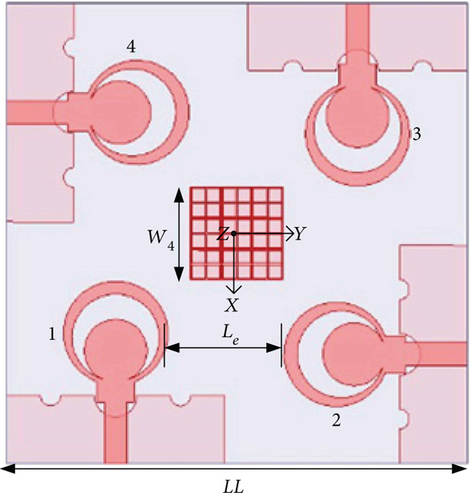
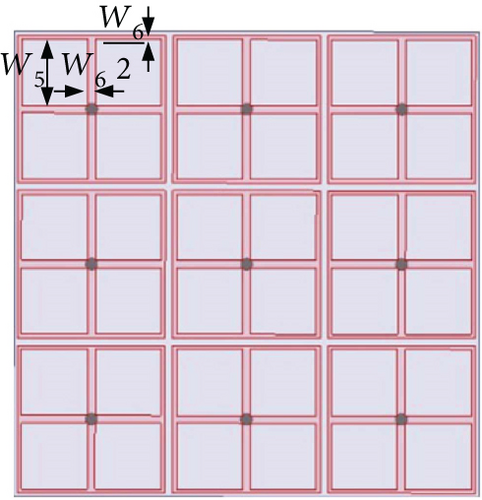
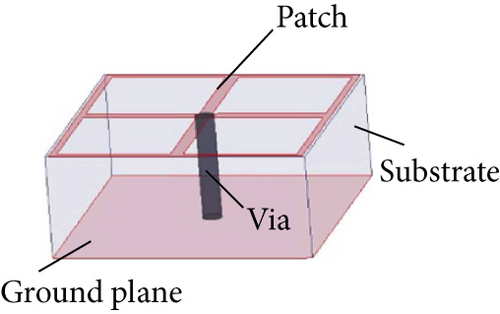

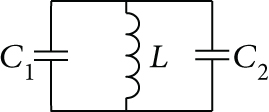
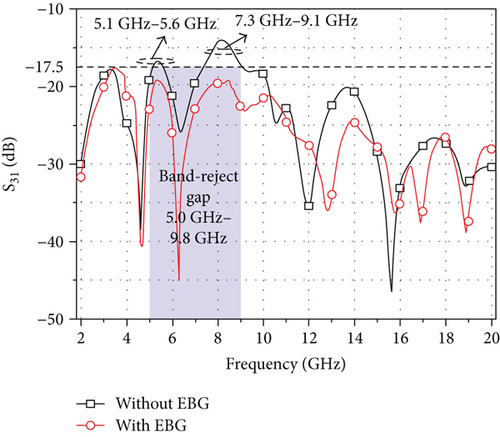
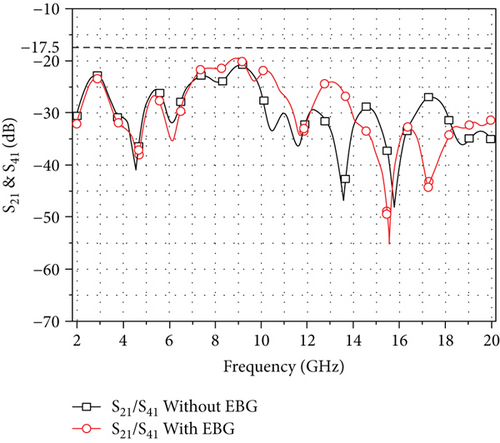
2.3. Investigation of Band-Reject Gap Properties
According to the initial parameters of the unit cell, dispersion characterization of surface waves propagating on the unit cell of EBG structures is investigated using finite integration technique (FIT) by CST MWS. The boundary conditions of side walls of the unit have to be considered periodic, and the boundaries at the top and the bottom of the model are defined as electric conductor, as illustrated in Figure 5(a). In order to cover the frequency band of 5.1–5.6 GHz and 7.3–9.1 GHz, the parameters of the unit cell are optimized as follows: W5 = 1.75 mm, W6 = 0.2 mm, W = 3.9 mm, and g = 0.1 mm. The numerically simulated k − β dispersion diagram of the surface modes propagating in the EBG structure is conducted using CST eigenmode solver, as shown in Figure 5(b). A complete band-reject between the first mode (TM0 mode) and the second mode (TE1 mode) in the frequency band of 5.0–9.8 GHz can be observed.Γ, X, and Mstand for symmetric points in the irreducible Brillouin zone. The Γ − X branch represents βxa/π with βy = 0, the X − M branch represents βya/π with βx = π/a, and the M − Γ branch represents βxa/π with βx = βy [10–14]. Because of slow-wave behavior of surface waves, dispersion curves are calculated only in the region under the light line, and the simulated frequency band-reject gap is from 5.0 to 9.8 GHz, as shown in Figure 5(b). Therefore, the isolation between the parallel elements has been enhanced from 17 dB to 20 dB within the band-reject gap of 5.1–5.6 GHz and 7.3–9.17 GHz when the 3 × 3 EBG array structures placed at the center of the dielectric substrate, which could be observed in Figure 4(a).
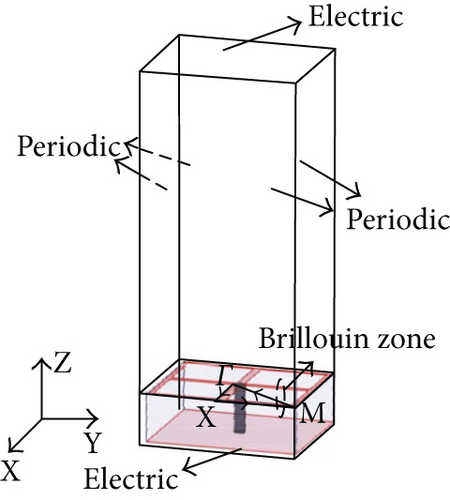

3. Measurement and Results
The proposed antenna is fabricated, as shown in Figure 6. Simulated and measured results of the quad-element UWB-MIMO antenna system are discussed in this section. The measurements of the proposed antenna are implemented by using Rohde and Schwarz ZVM vector network analyzer.
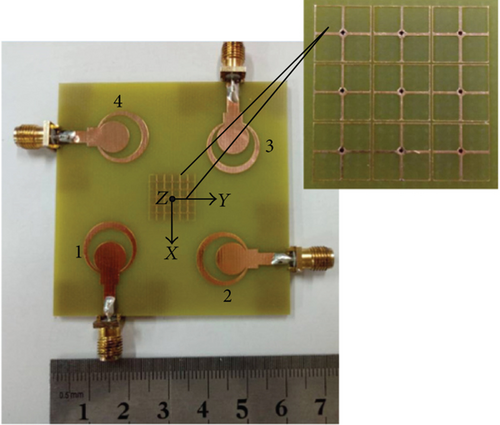
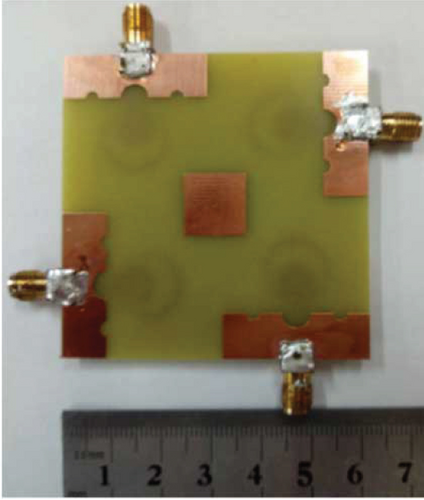
The simulated and measured S-parameters of the UWB-MIMO antenna are shown in Figure 7. The measured S-parameter under −10 dB level is from 3.0 to 16.2 GHz with a bandwidth of 137.5%, which is less than the simulated one from 3.0 to 20.0 GHz. Deviation of S11 curve occurs at high-frequency band between the measured result, and the simulated one is mainly due to the error of fabricating, welding, and testing. And reflection coefficient of the band-notched antenna at 4.6 GHz is about −2.4 dB, which can inhibit the interference of large capacity microwave relay trunk network from 4.0 to 5.2 GHz. From the curves of S-parameters, it can be observed that the antenna system exhibits a measured minimum isolation of 17.5 dB between its elements throughout the operating band. A comparison between the proposed antenna and few other recently reported planar MIMO designs in terms of bandwidth, mutual coupling, and size is shown in Table 1, where λ0 is the largest free-space wavelength corresponding to the lowest operating frequency of the referenced antennas. It can be observed that the proposed planar MIMO antenna has an excellent bandwidth performance, a good inhibitory ability to rejected frequency band, and has a compact size.
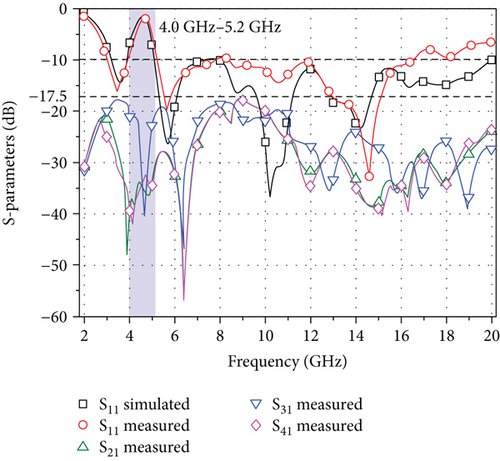
Far-field patterns are obtained inside an anechoic chamber for antenna 1, while the other three elements are terminated with 50 Ω impedances. Port 1 is measured due to the symmetrical of the proposed antenna, which leads to the same patterns when other ports are excited. Measured radiation patterns for xoz-plane, yoz-plane, and xoy-plane at 3.5, 10.5, and 16.2 GHz are shown in Figure 8. It is observed that cross-polarization at some planes is quite high because of the orthogonal arrangement of the four elements, which leads to the orthogonal of the electrical field. Peak gain and efficiency measurements are also performed and are plotted in Figure 9. Gain measurements show a peak gain of 8.4 dB at 16 GHz, and a peak efficiency of 91.2% is obtained at 10 GHz.
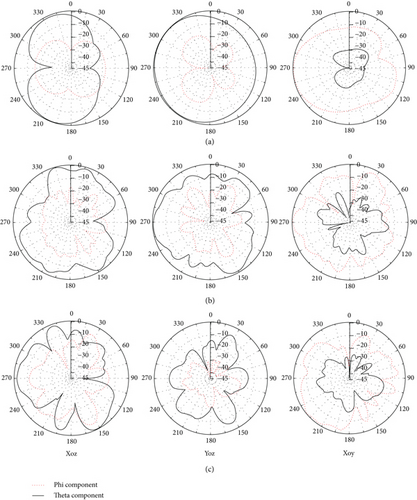
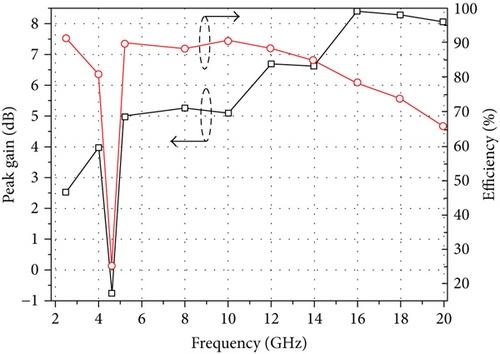
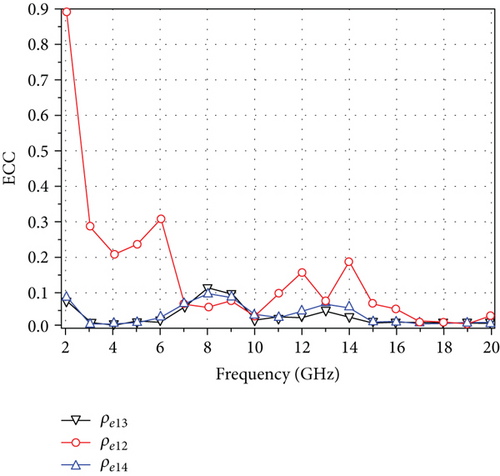
| MEG1 (dB) | MEG2 (dB) | MEG3 (dB) | MEG4 (dB) | DG (ρe12) | DG (ρe13) | DG (ρe14) | |||||
|---|---|---|---|---|---|---|---|---|---|---|---|
| XPD | 0 dB | 6 dB | 0 dB | 6 dB | 0 dB | 6 dB | 0 dB | 6 dB | |||
| 3G | −3.6 | −5.7 | −3.5 | −5.6 | −3.7 | −5.8 | −3.6 | −5.6 | 6.0 dB | 4.4 dB | 6.2 dB |
| 9G | −3.5 | −6.6 | −3.4 | −6.5 | −3.6 | −6.7 | −3.4 | −6.7 | 10.4 dB | 10.3 dB | 10.2 dB |
| 15G | −4.1 | −7.8 | −4.0 | −7.9 | −4.2 | −7.7 | −4.2 | −7.7 | 8.7 dB | 8.5 dB | 8.8 dB |
According to the four-port MIMO antenna system, TARC is a parameter that refers to the coupling of the ports, and its value is between 0 and 1, where 0 means all incident power is radiated, but 1 means all incident power is reflected. TARC curves for the proposed MIMO antenna with different phase combinations between the four elements are described in decibels in Figure 11. The excited port 1 is kept at 1ej0, while the other ports (i.e., ports 2, 3, and 4) are excited with different phases. For example, if the legend reads (120°, 180°, and 0°), it means that the excited phase of antenna 2 is at 120° shift with antenna 1, antenna 3 is at 180° shift, and antenna 4 is consistent with antenna 1. As evident from the figures, the simulated TARC curves have an agreement with the S11 curve at some phases shift (e.g., 180°, 0°, and 0°, 0°, 180°, and 0°, and 0°, 0°, and 180°) of the excited ports, where more incident power is radiated.
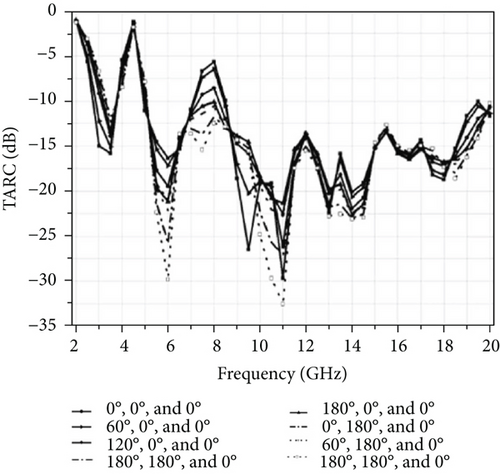
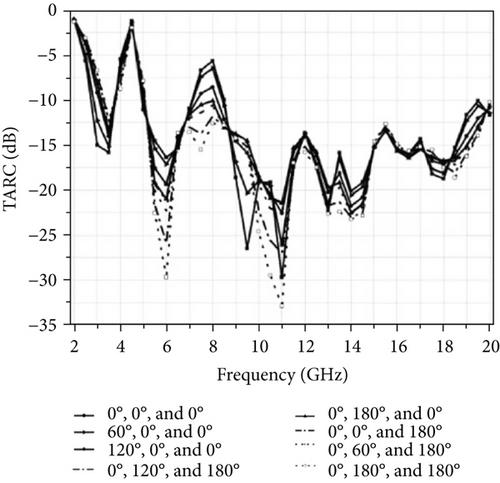
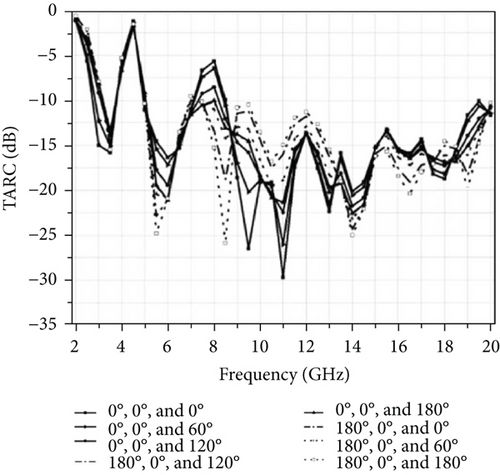
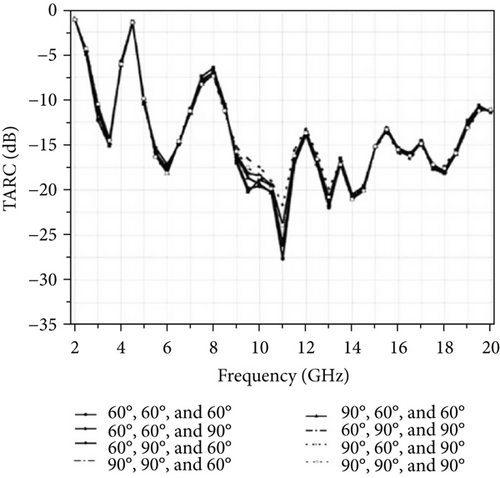
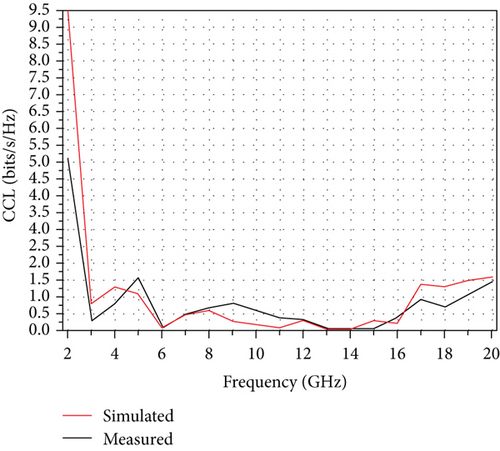
4. Conclusion
In this paper, a compact planar quad-element UWB-MIMO antenna with band-notch and reduced mutual coupling based on EBG structures is presented. The antenna is fabricated on a FR4 substrate and occupies a total size of 60 × 60 × 1.6 mm3. The antenna system exhibits good impedance matching across the −10 dB operating bandwidth. By etching four crescent ring-shaped resonant slots on the radiators, a sharp band-notched characteristic is achieved at 4.6 GHz. Low mutual coupling is achieved by orthogonal placement of the elements and loading EBG structures. The radiation efficiency, ECC, TARC, MEG, DG, and CCL have been calculated to evaluate the diversity performance of the proposed MIMO antenna. In short, the quad-element UWB-MIMO antenna with band rejection and high isolation has an application value in modern wireless communication systems.
Conflicts of Interest
The authors declare that they have no conflicts of interest.
Acknowledgments
This work was supported by the NSFC under Contract 61501153.




